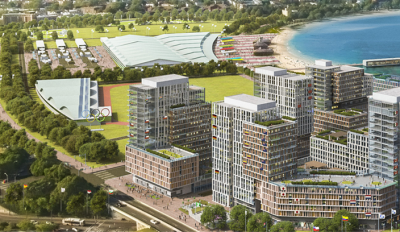July 8, 2015
 The Columbia Point peninsula would be transformed by Olympics Bid 2.0
The Columbia Point peninsula would be transformed by Olympics Bid 2.0
New York came into Boston in May and swept the Red Sox at home. Boston is in last place in the AL East while New York is at the top of the standings. Tomorrow night, the ancient rivals will begin another three-game series at Fenway Park.
Unfortunately for Boston’s beleaguered renters and homebuyers, New York is threatening to beat Boston on the affordable housing front as well. Last week, Boston 2024 released its so-called “Bid 2.0,” which included an ambitious plan for an Athletes’ Village at Columbia Point. The updated plan calls for 2,950 units in addition to another 2,700 beds that will serve as dorms for UMass Boston.
Exactly 385 of those spaces will be affordable and, apparently, all will be rental. That figure is 13 percent of the total and that is what is called for in the city’s Inclusionary Development Program. It is also what the developers at DotBlock have planned for their project at the intersection of Hancock DStreet and Dorchester Avenue. In fact, it is what all developers in Boston plan to do because they have to follow the existing standard set by the mayor’s office.
But it is disappointing to see Boston 2024 set the bar so low. Olympic organizers have promised long-term benefits to area residents from hosting the Games. One of those benefits should be more moderately priced housing in a city that desperately needs to retain its working-class residents.
Let’s look at the plan. First the benefits: It creates a new neighborhood in Dorchester with easy access to downtown, the beach, and the existing attractions on the Point. It also calls for a badly needed overhaul of Kosciuszko Circle and dorms for UMass. And it creates a neighborhood with upscale amenities that is designed to attract young professionals who have already been priced out of the South End or Jamaica Plain.
On the downside, it dramatically up-zones an already busy corner of the city and it fails to deliver much in the way of affordability for existing residents who want to stay in the neighborhood.
If we look 200 miles to the south, we can learn a lot from the experience in New York when the city made a bid to host the 2012 Games. Hudson Yards on the West Side of Manhattan was chosen to be the site for the Olympic stadium. When the bid came up short, Hudson Yards was turned into the site of a new neighborhood where New York hopes to build 20,000 housing units with nearly 5,000 of them being affordable.
The turnaround is also a cautionary tale because reports show that just 16 percent of the units already built are affordable. With increased pressure from Mayor de Blasio, both developers and advocates agree that the 25 percent figure is attainable. Still, the bar in New York is set almost twice as high as the one laid out by Boston 2024.
We may be resigned to the Red Sox finishing behind New York for second year in a row but we shouldn’t accept the same status in an Olympics competition. Boston 2024 should aim higher and show residents that permanently affordable housing, and not increased gentrification, can be a true legacy of our bid to host the Olympics in 2024.
Thomas Callahan is the executive director of the Massachusetts Affordable Housing Alliance.

